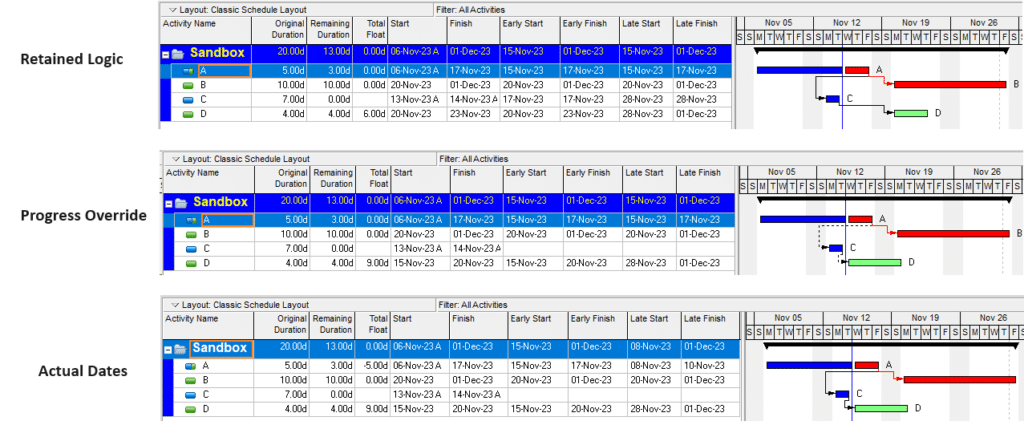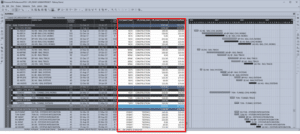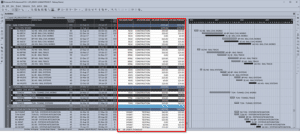By: Mehdi Takabi
Introduction
Many project schedulers and managers are familiar with addressing ‘out-of-sequence’ scenarios in project scheduling, especially in dealing with progress updates. Primavera P6 offers several scheduling options like ‘Retained Logic,’ ‘Progress Override,’ and ‘Actual Dates’ to manage these situations. However, the specifics of how the ‘Actual Dates’ option influences schedule calculations remain less explored. This article aims to delve into the behavior of ‘Actual Dates’ in Primavera P6 using various sample scenarios and clarifying its impact.

Understanding the ‘Actual Dates’ Setting
While Oracle’s definition suggests that ‘Actual Dates’ scheduling option is based on actual dates for backward and forward pass calculations, this explanation might not sufficiently address all concerns and potential confusion among schedulers and experts. Therefore, examining the real-world application of each scheduling option in different scenarios becomes essential to comprehend their nuances and impact.
Exploring Scheduling Options through Scenarios
Figure 2 demonstrates a simple schedule with four activities, showcasing a sequence where Activity A is the predecessor of Activity B & C and Activity C is the predecessor of Activity D.

In Figure 3, Activity C begins earlier than anticipated, causing an out-of-sequence situation. This scenario is used to illustrate how Primavera P6 operates under different scheduling options.

- Under ‘Retained Logic’ P6 respects network logic, scheduling the remaining part of Activity C after the completion of Activity A.
- In ‘Progress Override’, the software ignores network logic, allowing Activity C to continue regardless of its predecessor’s status.
- ‘Actual Dates’ mode, in this specific situation, the ‘Actual Dates’ mode functions similarly to the ‘Retained Logic.’ However, it causes Activity A to incur negative total float because Primavera P6 calculates total float using actual dates for backward network calculations. As a result, Activity A ends up with negative float, regardless of whether ‘Start Float’ or ‘Finish Float’ calculations are used for this activity.
Figure 4 illustrates the backward calculation, where the Late Finish of Activity A is determined based on the Actual Start date of Activity C, leading to negative total float for Activity A.

Figure 5 presents a scenario where Activity C is completed before the data date. Under ‘Retained Logic,’ Activity D remains unscheduled until the completion of Activity A. In ‘Progress Override,’ Activity D starts from the data date. In ‘Actual Dates’ mode, similar to ‘Progress Override,’ Activity D begins immediately, yet negative float for Activity A persists due to the use of actual dates for calculations.

As demonstrated, the ‘Actual Dates’ scheduling option can yield outcomes similar to ‘Retained Logic’ or ‘Progress Override,’ contingent on the status of the out-of-sequence activities. Additionally, it notably generates negative float in the schedule which needs to be accounted for.
Conclusion
In managing projects with Primavera P6, understanding the scheduling options like ‘Retained Logic,’ ‘Progress Override,’ and ‘Actual Dates’ is essential. While the software provides diverse methodologies, it is not advisable to depend solely on automated decisions (proceeding with default settings for scheduling options) to address out-of-sequence scenarios.
Owners should recommend the use of ‘Retained Logic’ by contractors to maintain logical sequence integrity. However, contractors must actively adjust logic relationships in cases of out-of-sequence activities, ensuring an accurate representation of the project’s plan and sequence of the works.
The success of a project significantly hinges on a cohesive, accurate schedule. By proactively understanding and strategically using Primavera P6’s scheduling options, stakeholders can ensure a reliable schedule, enabling better decision-making throughout the project’s lifecycle.



